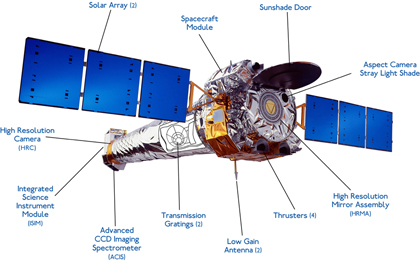Submitted by chandra on Tue, 2008-06-10 14:21
Submitted by chandra on Tue, 2008-06-10 14:21
Submitted by chandra on Mon, 2008-06-02 12:01
This week, the American Astronomical Society (AAS) holds its biannual meeting in St. Louis, Missouri. The AAS is the largest professional organization in North America and their meetings are intended to give scientists a chance to share their latest results through talks and poster sessions. This will be the 212th meeting and you can find out what's being talked about by looking here: http://aas.org/meetings/aas212/videos
Submitted by chandra on Tue, 2008-05-27 11:54
With the press release for G1.9+0.3 we talked about when an event in a distant part of the Milky Way galaxy occurred. One delicate issue that immediately came to mind was what to do about the light travel time to this object. We decided to adopt the astronomer's convention and talk about events in Earth's time frame, that is when the light reached the Earth, as we noted in the press release and in a few other places on our web-site.
Submitted by chandra on Tue, 2008-05-13 09:23
In the last year we have seen tremendous development in visualizing the Universe through the digital world. Google Sky and Wikisky are examples of this progress. These interfaces have taken well-known all-sky surveys and detailed observations to create virtual observatories that show our nearest planetary neighbors, like Mars and Jupiter, to the most distant galaxies in the Universe.
Submitted by chandra on Tue, 2008-05-13 09:09
Submitted by chandra on Wed, 2008-05-07 15:17
One of the most important tasks involved with having telescopes in space is keeping them at the correct and constant temperature. It's not just because telescopes like Chandra like to be comfortable – it's crucial in making the instruments perform as they should and return accurate science.

Interactive Chandra (flash)
Submitted by chandra on Mon, 2008-04-28 17:15
One of the most impressive accomplishments of the Chandra mission has been the improved understanding of the distant X-ray Universe. Chandra has accomplished this through deep X-ray surveys that generally involve pointing Chandra at a particular region of the sky that is not known to have any bright nearby objects and letting the camera collect X-ray light for an extended period of time.
Submitted by chandra on Tue, 2008-04-22 10:50
When we talk about what Chandra observes, we're usually discussing things like black holes or galaxies or stars. But Chandra is a pretty amazing telescope and it can study many things in the Universe – including the Earth.
Submitted by chandra on Wed, 2008-04-09 14:36
Here's a piece of high-energy astrophysics trivia (you never know when you might need to know these things). Where does the "X" in "X-ray" come from?
Pages